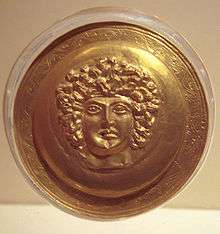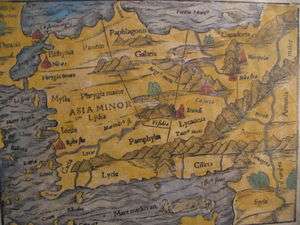Galatia
| Galatia | |
|---|---|
| Ancient Region of Anatolia | |
|
Location of Galatia in Anatolia | |
| Location | Central Anatolia |
| State existed | 280–64 BC |
| Successive languages | Galatian, Greek |
| Achaemenid satrapy | Cappadocia |
| Roman province | Galatia |
Ancient Galatia (/ɡəˈleɪʃə/; Greek: Γαλατία, Turkish: Galatlar) was an area in the highlands of central Anatolia (Ankara, Çorum, Yozgat Province) in modern Turkey. Galatia was named for the immigrant Gauls from Thrace (cf. Tylis), who settled here and became its ruling caste in the 3rd century BC, following the Gallic invasion of the Balkans in 279 BC. It has been called the "Gallia" of the East, Roman writers calling its inhabitants Galli (Gauls or Celts).
Geography
Galatia was bounded on the north by Bithynia and Paphlagonia, on the east by Pontus and Cappadocia, on the south by Cilicia and Lycaonia, and on the west by Phrygia. Its capital was Ancyra (i.e. Ankara, today the capital of modern Turkey).
Celtic Galatia
Seeing something of a Hellenized savage in the Galatians, Francis Bacon and other Renaissance writers called the inhabitants "Gallo-Graeci" or "Gauls settled among the Greeks", and the country "Gallo-Graecia", as had the 3rd-century AD Latin historian Justin.[1] The more usual term in Antiquity is Ἑλληνογαλάται (Hellēnogalátai) of Diodorus Siculus' Bibliotheca historica v.32.5, in a passage that is translated "...and were called Gallo-Graeci because of their connection with the Greeks", identifying Galatia in the Greek East as opposed to Gallia in the West.[2]
The Galatians originated as a part of the great Celtic migration, which invaded Macedon, led by Brennus. The original Celts who settled in Galatia came through Thrace under the leadership of Leotarios and Leonnorios c. 278/277 BC. These Celts consisted of three tribes, the Tectosages, the Trocmii, and the Tolistobogii.

Brennus invaded Greece in 281 BC with a huge war band, but was turned back before he could plunder the temple of Apollo at Delphi. At the same time, another Gaulish group of men, women, and children was migrating through Thrace. This had split off from Brennus' people in 279 BC, and had migrated into Thrace under its leaders Leonnorius and Lutarius. These invaders appeared in Asia Minor in 278–277 BC; others invaded Macedonia and killed the Ptolemaic ruler Ptolemy Ceraunus, but were eventually ousted by Antigonus Gonatas, the grandson of the defeated Diadoch Antigonus the One-Eyed.
The invaders came at the invitation of Nicomedes I of Bithynia, who wanted their help in a dynastic struggle against his brother. Three tribes crossed over from Thrace to Asia Minor. They numbered about 10,000 fighting men and about the same number of women and children, divided into three tribes, Trocmi, Tolistobogii and Tectosages. They were eventually defeated by the Seleucid king Antiochus I, in a battle where the Seleucid war elephants shocked the Celts. While the momentum of the invasion was broken, the Galatians were by no means exterminated.
Instead, the migration led to the establishment of a long-lived Celtic territory in central Anatolia, which included the eastern part of ancient Phrygia, a territory that became known as Galatia. There they ultimately settled, and strengthened by fresh accessions of the same clan from Europe, they overran Bithynia and supported themselves by plundering neighbouring countries. The Gauls invaded eastern Phrygia on at least one occasion.[3]
Strabo describes the constitution of the Galatian state: by custom, each tribe was divided into cantons, each governed by a chief ("tetrarch") followed by a judge, whose powers were unlimited except in cases of murder, which were tried before a council of 300 drawn from the 12 cantons and meeting at a holy place, 20 miles southwest of Ancyra, written in Greek as Δρυνεμετον (Drunemeton or Drynemeton, Gaulish *dru-nemeton "holy place of oak"). It is likely it was a sacred oak grove, since the name means "sanctuary of the oaks" (from drus, meaning "oak" and nemeton, meaning "sacred ground"). The Galatian arrivals left the local population of Cappadocians in control of the towns and most of the land, paying tithes to their new overlords, who formed a military aristocracy and kept aloof in fortified farmsteads, surrounded by their bands.
These Celtic warriors were respected by Greeks and Romans (illustration, below). They were often hired as mercenary soldiers, sometimes fighting on both sides in the great battles of the times. For years, the chieftains and their war bands ravaged the western half of Asia Minor, as allies of one or other of the warring princes, without any serious check. This ended when they sided with the renegade Seleucid prince Antiochus Hierax ruling in Asia Minor, who tried to defeat Attalus, the ruler of Pergamon (241–197 BC). Instead, the Hellenized cities united under Attalus's banner, and his armies inflicted several grave defeats upon them, about 232 forcing them to settle permanently and to confine themselves to the region to which they had already given their name. The theme of the Dying Gaul (a famous statue displayed in Pergamon) remained a favorite in Hellenistic art for a generation.

Their right to the district was formally recognized. The three Celtic Galatian tribes remained as described above:
- the Tectosages in the centre, round their capital Ancyra
- the Tolistobogii on the west, round Pessinus as their chief town, sacred to Cybele
- the Trocmi on the east, round their chief town Tavium
Each tribal territory was divided into four cantons or tetrarchies. Each of the twelve tetrarchs had under him a judge and a general. A council of the nation consisting of the tetrarchs and three hundred senators was periodically held at Drynemeton.
The king of Attalid Pergamon hired Galatians in the increasingly devastating wars of Asia Minor. One of the tribes in his service, the Aigosages, refused to obey after a lunar eclipse on 1 September 218 BC. Another band deserted from their Egyptian overlord Ptolemy IV (reigned 221-204 BC) after a solar eclipse had broken their spirits.
In the early 2nd century BC, they proved terrible allies of Antiochus the Great (ruled 222–187 BC), the last Seleucid king who tried to regain suzerainty over Asia Minor. In 189 BC, Rome sent Gnaeus Manlius Vulso on an expedition against the Galatians, the Galatian War. He defeated them. Rome then dominated Galatia through regional rulers from 189 BC onward. Galatia declined and fell at times under Pontic ascendancy. The Galatians were finally freed by the Mithridatic Wars of 88-63 BC, during which they supported Rome.
In Pompey's administrative settlement of 64 BC, Galatia formally became a client-state of the Roman empire, the old constitution disappeared, and three chiefs (wrongly styled "tetrarchs") were appointed, one for each tribe. But this arrangement soon gave way before the ambition of one of these "tetrarchs", Deiotarus, the contemporary of Cicero and Julius Caesar, who made himself master of the other two tetrarchies and was finally recognized by the Romans as "king" of Galatia.
 A Galatian's head as depicted on a gold Thracian objet d'art, 3rd century BC. Istanbul Archaeological Museum.
A Galatian's head as depicted on a gold Thracian objet d'art, 3rd century BC. Istanbul Archaeological Museum.
 Galatian bracelets and earrings, 3rd century BC, Hidirsihlar tumulus, Bolu. Istanbul Archaeological Museum.
Galatian bracelets and earrings, 3rd century BC, Hidirsihlar tumulus, Bolu. Istanbul Archaeological Museum. Galatian torcs, 3rd century BC, Hidirsihlar tumulus, Bolu. Istanbul Archaeological Museum.
Galatian torcs, 3rd century BC, Hidirsihlar tumulus, Bolu. Istanbul Archaeological Museum. Galatian plate, 3rd century BC, Hidirsihlar tumulus, Bolu. Istanbul Archaeological Museum.
Galatian plate, 3rd century BC, Hidirsihlar tumulus, Bolu. Istanbul Archaeological Museum. Galatian object, 3rd century BC, Hidirsihlar tumulus, Bolu. Istanbul Archaeological Museum.
Galatian object, 3rd century BC, Hidirsihlar tumulus, Bolu. Istanbul Archaeological Museum.
Roman Galatia


Upon the death of Deiotarus, the Kingdom of Galatia was given to Amyntas, an auxiliary commander in the Roman army of Brutus and Cassius who gained the favor of Mark Antony.[4] After his death in 25 BC, Galatia was incorporated by Augustus into the Roman Empire, becoming a Roman province. Near his capital Ancyra (modern Ankara), Pylamenes, the king's heir, rebuilt a temple of the Phrygian god Men to venerate Augustus (the Monumentum Ancyranum), as a sign of fidelity. It was on the walls of this temple in Galatia that the major source for the Res Gestae of Augustus were preserved for modernity. Few of the provinces proved more enthusiastically loyal to Rome.
Josephus related the Biblical figure Gomer to Galatia (or perhaps to Gaul in general): "For Gomer founded those whom the Greeks now call Galatians, [Galls], but were then called Gomerites."[5] Others have related Gomer to Cimmerians.
Paul the Apostle visited Galatia in his missionary journeys,[6] and wrote to the Christians there in the Epistle to the Galatians.
Although originally possessing a strong cultural identity, by the 2nd century AD, the Galatians had become assimilated (Hellenization) into the Hellenistic civilization of Anatolia.[7] The Galatians were still speaking the Galatian language in the time of St. Jerome (347–420 AD), who wrote that the Galatians of Ancyra and the Treveri of Trier (in what is now the Rhineland) spoke the same language (Comentarii in Epistolam ad Galatos, 2.3, composed c. 387).
In an administrative reorganisation (circa 386–95), two new provinces succeeded it, Galatia Prima and Galatia Secunda or Salutaris, which included part of Phrygia. The fate of the Galatian people is a subject of some uncertainty, but they seem ultimately to have been absorbed into the Greek-speaking populations of Anatolia.
There was a short-lived 11th century attempt to re-establish an independent Galatia by Roussel de Bailleul.
See also
Notes
- ↑ Justin, Epitome of Pompeius Trogus, 25.2 and 26.2; the related subject of copulative compounds, where both are of equal weight, is exhaustively treated in Anna Granville Hatcher, Modern English Word-Formation and Neo-Latin: A Study of the Origins of English (Baltimore: Johns Hopkins University), 1951.
- ↑ This distinction is remarked upon in William M. Ramsay (revised by Mark W. Wilson), Historical Commentary on Galatians 1997:302; Ramsay notes the 4th century AD Paphlagonian Themistius' usage Γαλατίᾳ τῇ Ἑλληνίδι.
- ↑ Pliny. Natural History, 5.42.
- ↑ It appears Amyntas was quite prodigious in striking coins for his various exploits (with his title as King) —Asia Minor Coins – Amyntas
- ↑ Josephus. Antiquities of the Jews, I:6.
- ↑ Acts 16:6 and Acts 18:23
- ↑ Galatia
References
| Wikimedia Commons has media related to Galatia. |
 This article incorporates text from a publication now in the public domain: Chisholm, Hugh, ed. (1911). "article name needed". Encyclopædia Britannica (11th ed.). Cambridge University Press.
This article incorporates text from a publication now in the public domain: Chisholm, Hugh, ed. (1911). "article name needed". Encyclopædia Britannica (11th ed.). Cambridge University Press.- Encyclopedia, MS Encarta 2001, under article "Galatia".
- Barraclough, Geoffrey, ed. HarperCollins Atlas of World History. 2nd ed. Oxford: HarperCollins, 1989. 76–77.
- John King, Celt Kingdoms, pg. 74–75.
- The Catholic Encyclopedia, VI: Epistle to the Galatians.
- Stephen Mitchell, 1993. Anatolia: Land, Men, and Gods in Asia Minor vol. 1: "The Celts and the Impact of Roman Rule." (Oxford: Clarendon Press) 1993. ISBN 0-19-814080-0. Concentrates on Galatia; volume 2 covers "The Rise of the Church". (Bryn Mawr Classical Review)
- David Rankin, (1987) 1996. Celts and the Classical World (London: Routledge): Chapter 9 "The Galatians".
- Coşkun, A., "Das Ende der "romfreundlichen Herrschaft" in Galatien und das Beispiel einer "sanften Provinzialisierung" in Zentralanatolien," in Coşkun, A. (hg), Freundschaft und Gefolgschaft in den auswärtigen Beziehungen der Römer (2. Jahrhundert v. Chr. – 1. Jahrhundert n. Chr.), (Frankfurt M. u. a., 2008) (Inklusion, Exklusion, 9), 133–164.
- Justin K. Hardin: Galatians and the Imperial Cult. A Critical Analysis of the First-Century Social Context of Paul's Letter. Mohr Siebeck, Tübingen, Germany 2008, ISBN 978-3-16-149563-2.
External links
- Celtic Galatians
- "A Detailed Map of Celtic Settlements in Galatia" (PDF). (1.60 MB)
- UNRV.com: Galatia
Coordinates: 40°00′N 33°30′E / 40.0°N 33.5°E



